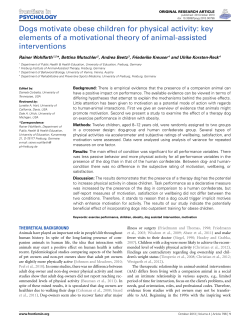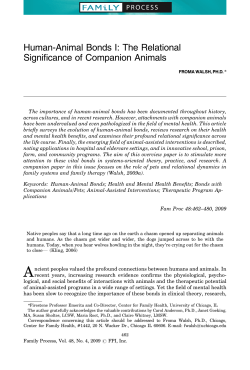
ANIMAL&ASSITED+THERAPY+ 1+ + Animal-Assisted Therapy: A Concept Analysis
ANIMAL&ASSITED+THERAPY+ + 1+ Animal-Assisted Therapy: A Concept Analysis Annette Kowalczyk !DePaul University ANIMAL&ASSITED+THERAPY+ + 2+ Introduction Concepts provide the foundation to clarify and define theory development and research that effects nursing practice. The concept animal-assisted therapy was chosen for this analysis because of its effective, but underutilized use in health care, and because AAT is what I have chosen as my service learning. I have just gotten involved in an organization called Rainbow Animal-Assisted Therapy to train one of my own dogs as a therapy dog. This will serve as a component of DePaul’s service learning, and I look forward to continuing to do AAT indefinitely throughout my career in health care and beyond. Walker and Avant (2011) have introduced a concise, Eight-step method that was developed from Wilson’s fifteen-step method. This 8-step method guides concept analysis to be utilized in nursing. The analysis of animal-assisted therapy will follow the Walker and Avant (2011) method as listed below: 1. Select a concept 2. Determine the aims or purpose of your analysis 3. Identify uses of the concept 4. Determine defining attributes 5. Construct a model case 6. Construct borderline, related, contrary, invented, and illegitimate cases 7. Identify antecedents and consequences 8. Define empirical referents Step six will not be included in this analysis Selection of Concept and Purpose of Analysis The goal of this concept analysis is describe the work of animal-assisted therapy and how ANIMAL&ASSITED+THERAPY+ + 3+ it is currently used as a complementary alternative medicine. Descriptions of animal-assisted theory were found in research papers as well as articles written by people who have participated in animal-assisted theory. Searches in the EBSCO and CINAHL databases utilizing the key word animal therapy produced 322 results. The terms animal therapy and nurse produced 7 results; and animal therapy and chronic produced 13 results. Limitations for the search were the limited number of animal therapy articles related to nursing and chronically ill patients. No concept analyses of animal therapy were found. In order to have a clear understanding of how animal-assisted therapy can be used in my own patient care, it will be imperative to observe how it has been used and also in what situations it has been used successfully. Uses of the Concept The concept animal-assisted therapy has become used more frequently over the past twenty years. According to Cole, Gawlinski, Steers & Kotleman (2007), animal-assisted therapy for patients with heart failure decreases heart rate and blood pressure while improving anxiety. They also have concurred that dog ownership is an independent and significant predictor of survival one year post a myocardial infarction. Barker and Dawson (1998) report longer survival rates following myocardial infarction for pet owners when compared with people without pets. Barker and Dawson (1998) define define animal-assisted therapy as “the use of trained animals in facilitating patients’ progress toward therapeutic goals.” (p. 797) The Oxford English Dictionary Online (OED, 2012) defines therapy in two ways: “1. The medical treatment of disease; curative medical or psychiatric treatment; 2. As the final element in words denoting treatment by means expressed in the first element.” The original word “therapy” dates back to 1846, according to OED. Barker and Dawson define animal-assisted therapy by saying “Animal-assisted therapy involves interaction between ANIMAL&ASSITED+THERAPY+ + 4+ patients and a trained animal, along with its human owner or handler, with the aim of facilitating patients’ progress toward therapeutic goals.” (p. 797) “AAT is a goal-directed intervention in which an animal meeting specific criteria is an integral part of the treatment process. AAT is delivered and/or directed by a health/human service provider working within the scope of his/her profession. AAT is designed to promote improvement in human physical, social, emotional, and/or cognitive functioning, thinking and intellectual skills. AAT is provided in a variety of settings and may be group or individual in nature. The process is documented and evaluated” (Delta Society, 2004, p. 11). I believe there are many perspectives on animal-assisted therapy. Kruger and Serpell (2006) suggest that a clear and definite indication be made between an emotional response to animals and actual therapy. Kruger and Serpell (2006) go on to say, “It should not be concluded that any event enjoyed by the patient is a kind of therapy.” Current uses of animal assisted therapy have been distinguished as follows: • In a study conducted on patients with heart failure, visiting with a therapy animal significantly improved hemodynamic measures, reduced neurohormone levels and state anxiety levels in a patient. This is in comparison to their baseline information while receiving usual care with no other variables (Liebert, 2010). • Therapeutic benefits of a companion dog for patients with schizophrenia included helping to ground the patient in reality (Barker and Dawson, 1998). • When puppies visited the homes of severe mentally ill patients, the therapy of this example was the contact of the animal with the participant (Barker & Dawson, 1998). ANIMAL&ASSITED+THERAPY+ + • 5+ In the early 1960’s Dr. Boris Levinson discovered the possibilities of using animals in a therapeutic realm by discovering that a chance encounter with his dog. The interaction of the child with the dog elicited the first verbal communication with a disturbed, nonverbal child (Hawkins, 2012). • A nurse at Advocate Good Samaritan Hospital oversees the pet therapy program at the hospital in Downers Grove, Ill., and she describes how she has seen pets provide healing to patients in ways that medicine was unable to (Pierri, 2013). • Animal-assisted therapy reduced epinephrine and norepinephrine levels in patients who participated in a study. These suggested changes in the activation of the autonomic nervous system in Cole, et al.’s (2007) study are the therapy provided by the animal and it’s handler. Defining Attributes According to Walker and Avant (2011), a concept’s defining attributes are characteristics that appear many times within each piece of literature. Based on the review and analysis of available literature, dictionary definitions, and repetitive occurrences of certain characteristics within animal-assisted therapy, the defining attributes are as follows: • Animal-assisted therapy (AAT) is a partnership between an animal and a trainer who seek to help patients improve their health through visiting organizations in which patients reside • Interactions between trained animals and patients that induce a change in the status of the patient ANIMAL&ASSITED+THERAPY+ + 6+ • Animal-assisted therapy can be conducted in either acute or chronic environments. • Research and studies conducted guide the utilization of animal-assisted therapy in many different environments • Animal trainers who have a passion for helping people are often the motivating forces to organize training and also lobby for this type of therapy to be utilized Model Case ! A school had just enrolled a new 15-year-old female student. Her mother had sent her to the school in hopes of saving the girl from serious self-destructive behaviors that included cutting and drug abuse. The student spent much of her first day refusing to eat or communicate with anyone. She met the school counselor in one of the counseling rooms where she was folding herself into the fetal position. Offers to help her was ignored and she was nonresponsive. The counselor, having just lost her therapy dog, began telling the student of this very special dog and all the good he had accomplished. As the counselor went on and on about her dog, she heard a very faint, "Thirteen." Thirteen? "I HAVE THIRTEEN!" the student cried. She explained that she had thirteen animals at home. She felt she had abandoned them by coming to school. Recognizing her grief and the sense of duty she felt in caring for her animals, her team of counselors was able to incorporate her passion for animals into her care plan. This student was later selected to work with the on-campus Search and Rescue Dog program, and over the next year her self-confidence and self-respect increased dramatically. This student took the interaction of the therapy dog and trainer as a therapy in itself (Hawkins, 2012). ANIMAL&ASSITED+THERAPY+ + 7+ Antecedents and Consequences Walker and Avant (2011) explain that antecedents are events or situations that must occur prior to the occurrence of the concept. An antecedent to the concept of animal assisted therapy is that patients that will benefit from AAT the most had either a chronic condition of mental illness or cardiovascular illness, but not limited to any specific illness (Barker, 1998; Banks et. all, 2008) Consequences are events that occur as a result of the occurrence, or outcome of the concept. One consequence could be a negative response to a particular patient who has a dislike for animals or negative association with an animal or certain type of animal. The effectiveness and demeanor of the training will also have a role in the consequence of the AAT occurrence. Banks, Willoughby and Banks (2008) state, “We found here that elderly residents living in long-term care facilities who received scheduled AAT with either a living or robotic dog were significantly less lonely than those who did not receive AAT. We found no difference between the effectiveness of a living and robotic dog in reducing loneliness” (p. 175-176). This study shows us that AAT can be extended to robotic, non-human, entities as points of therapy to people patients who may be allergic or fearful of dogs. Animal-assisted therapy (AAT) can reduce stress and anxiety of patients with a broad range of illnesses, and can elicit responses in some cases were no other methods of therapy had been successful particularly in cases of mental health. AAT can benefit in a wide variety of mental health, cardiovascular and general well-being situations. ANIMAL&ASSITED+THERAPY+ + 8+ Empirical Referents Defining empirical referents is the final step in the concept analysis. Walker and Avant (2011) explain empirical referents as “classes or categories of actual phenomena that by their existence or presence demonstrate the occurrence of the concept itself” (p. 168). Empirical referents for the concept of Animal-Assisted therapy can be observed quantitative, but with a focus on qualitative. Quantitative empirical referents include decreased blood pressure or heart rate after AAT interactions, reduced loneliness for patients involved with AAT (Banks & Banks, 2007), and adverse events (Benn, et al., 2002). Among the empirical referents seen more qualitatively is the culture of anxiety reduction. This phenomenon can be observed from all parties involved in the patient’s care that are able to observe a patient before a therapy session and after a therapy session. On a larger scale, empirical referents of animal assisted therapy include initiation, support, willing participants, and organizations open to animal-assisted therapy as a whole. On a smaller scale, empirical referents include natural way of establishing a social symbiotic relationship between the human and animal, with the first steps taken by the therapy animal and it’s trainer (Odendaal, 2000). The final empirical referent of animal-assisted therapy combines both quantitative and qualitative properties. It is the idea that looking at both quantitative and qualitative information for the results of AAT can determine success, as opposed to look at either quantitative or qualitative. Niska (2007) tells us, “I sometimes hear animal lovers say that they like pets more than people, and this makes me sad. Human beings are an intelligent and complex animal, ANIMAL&ASSITED+THERAPY+ + 9+ capable of both great and terrible things. When we do not like other people, it is usually because we do not understand their behavior. As I explain to the clients I work with, understanding is the source of our highest power. Animals and nature can help us achieve this understanding by teaching us about ourselves and about others. That is the basis of animal-assisted therapy” (p. 58). This is a good example of qualitative information that can be used to support quantitative research. Conclusion The concept of AAT as a CAM can be a great asset to the medical profession in patients with many different conditions. There are many different AAT organizations such as Pet Partners and TDI (Therapy Dogs International) on a national and local level in addition to in-house animals at some hospitals. There is a need for more data to help NPs, nurses, physicians, psychologists and psychiatrists to see the benefits of AAT for themselves. There are some nurses that have taken on coordinating therapy dog programs, and there are many nurses in the animal-assisted therapy course in which I am currently enrolled. I believe that the therapy dog course will help me to have a better understanding of how I can encourage and support this CAM, and how I can best utilize it in my own career as a nurse. ANIMAL&ASSITED+THERAPY+ + 10+ References Banks, M. R., Banks W.A. (2002). "The effects of animal-assisted therapy on loneliness in an elderly population in long-term care facilities." Banks, M. R., Willoughby, L., Banks, W.A (2008). "Animal-Assisted Therapy and Loneliness in Nursing Homes: Use of Robotic versus Living Dogs." JAMDA: 5. Barker, S.B., Dawson, K.S. (1998). "The Effects of Animal-Assisted Therapy on Anxiety Ratings of Hospitalized Psychiatric Patients." Psychiatric Services 49(6): 6. Cole, K. M., Gawlinski, A., Steers, N., Kotlerman, J. (2007). "Animal Assisted Therapy in Patients Hospitalized with Heart Failure." American Journal of Critical Care 16(6): 12. Delta Society. (2004). Team training course manual. (6th ed.). Renton, Washington: Delta Society. Hawkins, C. (2012). "Animal Therapy: Is there Room in the Treatment Plan?" Exceptional Parent Magazine: 4. Hooker, S., Freeman, L., Stewart, P. (2002). Pet Therapy Research: A Historical Review. Holistic Nursing Practice. Kruger, A. a. S., J. (2006). "Animal-Assisted Interventions in Mental Health: Definitions and Theoretical Foundations." 18. Niksa, E. (2007). "The Use of Animal-Assisted Therapy in Psychiatric Nursing: The Story of Timmy and Buddy." Journal of Psychosocial Nursing and Mental Health Services: 4. Odendaal, J. S. J. (2000). "Animal-assisted therapy - magic or medicine? " Journal of Psychosomatic Research 49: 6.
© Copyright 2025



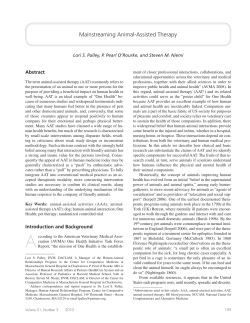



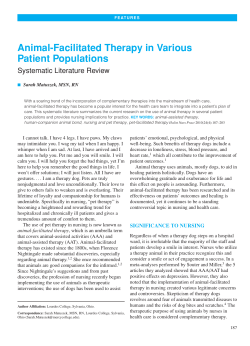
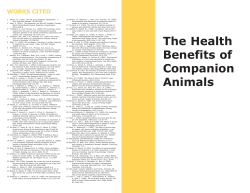
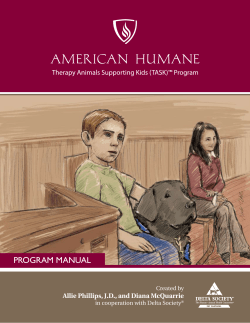

![TMRE [Tetramethylrhodamine ethyl ester]](http://cdn1.abcdocz.com/store/data/000008077_2-57b5875173b834fce2711afeb6b289d6-250x500.png)

